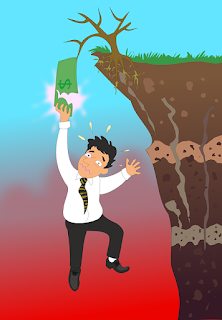Bankruptcy Facts
We've talked about getting out of debt using debt consolidation and debt settlement. But what if those methods aren't of any use to you because you are just too far in debt?
Then you may have to consider bankruptcy. Sometimes that is the only way out but there are things you should know.
You can't file bankruptcy on your own. You need a bankruptcy trustee to do that and the trustees will charge you fees for this service - from several hundred dollars to $1,000 in court filings and legal fees. And the trustee's job is to get as much as possible for the creditors.
The trustee is going to want you to keep track of your spending while the bankruptcy is being arranged. They are also going to need to know your assets. A portion of your income during the first months before the bankruptcy is discharged will go to your creditors and if you happen to come into a lot of money before the bankruptcy is discharged, these funds will go to the trustee and to the creditors.
Once the paperwork is filed, you're officially "bankrupt" for nine months. However, new rules in 2009 have allowed for this period to be longer if your monthly net income is $200 or more over the allowable threshold, the bankruptcy may be extended by 12 months or up to 21 months.
The debts that are discharged in a bankruptcy are the unsecured ones like credit cards and lines of credit. Student loans are generally not cancelled if the bankruptcy is filed within seven years of finishing your studies. (However, if you are experiencing financial hardship you can apply to be released from your student loans five years after you stop being a student.)
If you have more than $200,000 in personal income tax debt and this makes up 75% or more of your total unsecured debt, then you aren't eligible for an automatic discharge. You will have to request a court order to have your debts discharged.
First time bankruptcies stay on a person's credit rating for six years. The second time, those R9s are there for fourteen years.
There is a little bit of information on filing for bankruptcy in Canada. Naturally, each province will have slightly different rules so be sure to consult a trustworthy bankruptcy trustee for more information.
If you feel that you are ready to gain control of your debt, then stop trying to figure it all out on your own and make sure you don’t go another year without gaining control —click here
I might be able to help you by supporting you through the 5-Step Financial Stability program that I have used to get control of my financial situation. click here
To your success,
Karen Magill
P.S. It is NOT right for everyone – but if you feel having me working with you almost “daily” & giving you a proven step by step system to follow will help you get your finances and life back on track then for more details. - click here
Then you may have to consider bankruptcy. Sometimes that is the only way out but there are things you should know.
You can't file bankruptcy on your own. You need a bankruptcy trustee to do that and the trustees will charge you fees for this service - from several hundred dollars to $1,000 in court filings and legal fees. And the trustee's job is to get as much as possible for the creditors.
Once the paperwork is filed, you're officially "bankrupt" for nine months. However, new rules in 2009 have allowed for this period to be longer if your monthly net income is $200 or more over the allowable threshold, the bankruptcy may be extended by 12 months or up to 21 months.
The debts that are discharged in a bankruptcy are the unsecured ones like credit cards and lines of credit. Student loans are generally not cancelled if the bankruptcy is filed within seven years of finishing your studies. (However, if you are experiencing financial hardship you can apply to be released from your student loans five years after you stop being a student.)
If you have more than $200,000 in personal income tax debt and this makes up 75% or more of your total unsecured debt, then you aren't eligible for an automatic discharge. You will have to request a court order to have your debts discharged.
First time bankruptcies stay on a person's credit rating for six years. The second time, those R9s are there for fourteen years.
There is a little bit of information on filing for bankruptcy in Canada. Naturally, each province will have slightly different rules so be sure to consult a trustworthy bankruptcy trustee for more information.
If you feel that you are ready to gain control of your debt, then stop trying to figure it all out on your own and make sure you don’t go another year without gaining control —click here
I might be able to help you by supporting you through the 5-Step Financial Stability program that I have used to get control of my financial situation. click here
To your success,
Karen Magill
P.S. It is NOT right for everyone – but if you feel having me working with you almost “daily” & giving you a proven step by step system to follow will help you get your finances and life back on track then for more details. - click here










Comments
Post a Comment